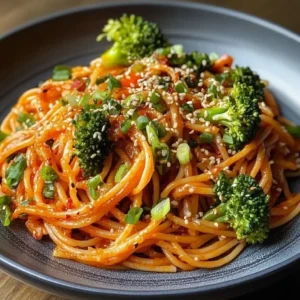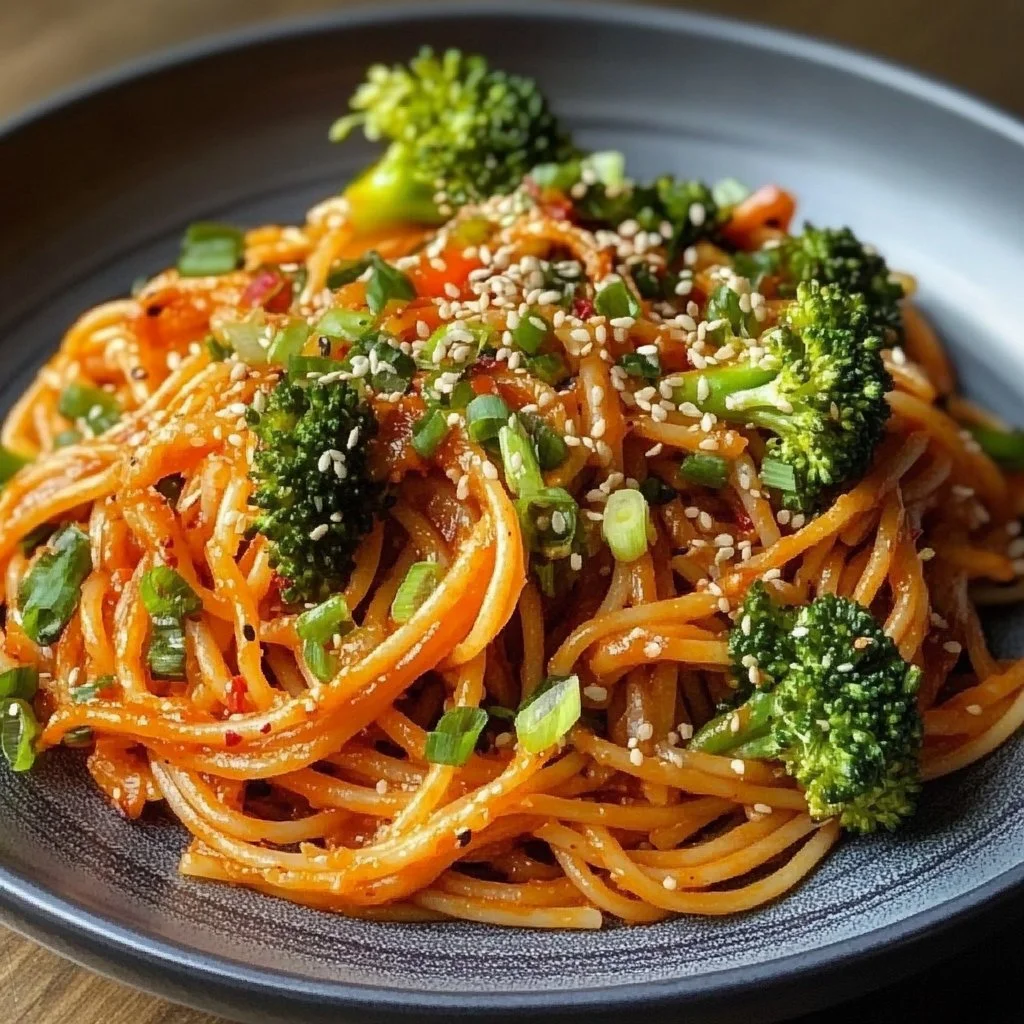This post may contain affiliate links. As an Amazon Associate, I earn from qualifying purchases at no extra cost to you.
Table of Contents
Are you looking for a dish that combines unique flavors with ease of preparation? Gochujang Pasta may be precisely what you need. This delightful recipe blends traditional Korean gochujang paste with the comforting texture of pasta. Imagine enjoying a bowl of spaghetti coated in a sweet, spicy, and savory sauce. It’s a delightful fusion that respects both cuisines and your taste buds.
What makes Gochujang Pasta special is its versatility. You can whip it up for a quick weeknight dinner or dress it up for a special occasion. It’s adaptable to various dietary preferences and can be modified with your favorite vegetables. The bustling flavors from the gochujang provide depth, melding beautifully with the crunch of fresh veggies.
Do you often struggle to find recipes that are both quick and delicious? Well, Gochujang Pasta offers the best of both worlds. With just a handful of ingredients and simple steps, you can make a dish that feels gourmet. Plus, it’s likely your family will love it, making it a perfect choice for both kids and adults alike. Whether sitting down for dinner on a busy night or serving guests, this dish rises to the occasion.
Are you intrigued? Let’s delve into why Gochujang Pasta stands out and why it might just become your new go-to recipe.
🍴 Top Kitchen Essentials You'll Love
Key Benefits of Gochujang Pasta
Why You’ll Love This Recipe
- Flavorful Fusion: The combination of spicy gochujang, savory soy sauce, and nutty sesame oil creates an explosion of flavors.
- Simplicity: With only a few ingredients, you can whip this up in no time.
- Versatile: Choose your favorite vegetables or proteins to customize the dish.
- Family-Friendly: A perfect balance of flavors ensures that everyone at the table will enjoy it.
- Meal Prep Friendly: It stores well, making it an excellent choice for meal prep.
- Balanced Nutrition: Incorporating veggies provides essential nutrients while delivering comfort in every bite.
What Makes It Stand Out
Gochujang Pasta is unique due to the inclusion of gochujang, a fermented chili paste that adds a depth of flavor often missing in traditional pasta dishes. This originality encourages creativity, inviting you to experiment with different ingredients or adjust the spice level.
The dish is also highly customizable. Are you a vegetarian? Add more veggies or tofu. Seeking protein? Chicken or shrimp can elevate it. Moreover, it’s perfect for various occasions, whether a casual family meal or a cozy dinner party. The vibrant colors and enticing aroma make it visually appealing and appetizing.
Ingredients for Gochujang Pasta
Complete Ingredient List with Measurements
- 8 oz pasta (spaghetti or your choice)
- 2 tablespoons gochujang
- 1 tablespoon soy sauce
- 1 tablespoon sesame oil
- 2 cloves garlic, minced
- 1 cup mixed vegetables (bell peppers, zucchini, carrots)
- 1 tablespoon olive oil
- Salt and pepper to taste
- Chopped green onions for garnish
- Sesame seeds for garnish
The pasta of your choice can set the tone of the dish. Spaghetti is versatile, but feel free to explore other types like udon or rice noodles if you want a different texture. The mixed vegetables can be as varied as your preferences, giving you options based on what’s in season or your dietary needs.
Substitutes and Alternatives
If you have dietary restrictions or preferences, there’s no need to miss out on this delicious Gochujang Pasta. For a gluten-free option, substitute regular pasta with gluten-free noodles made from rice or quinoa. For those avoiding soy, coconut aminos can serve as an excellent alternative to soy sauce.
If gochujang is hard to find, consider using sriracha or another spicy chili paste, keeping in mind the flavor may differ slightly. Furthermore, if sesame oil isn’t available, olive oil works decently, though it won’t provide the same nutty undertone. Always feel free to incorporate whatever fresh vegetables you have on hand to keep it fresh and exciting.
How to Make Gochujang Pasta – Step-by-Step Directions
Step 1 – Prepare Ingredients
Start by gathering and measuring all your ingredients. This step ensures a smooth cooking process, allowing you to enjoy every moment without stress.
Step 2 – Cook the Pasta
Bring a large pot of salted water to a boil. Add your pasta and cook according to package instructions until al dente. Drain the pasta, reserving a bit of the cooking water in case you need to thin the sauce later.
Step 3 – Sauté the Garlic
In a large skillet, heat the olive oil over medium heat. Add the minced garlic and sauté for about 30 seconds until fragrant. Be careful not to burn it, as burnt garlic can introduce a bitter taste.
Step 4 – Add Mixed Vegetables
Next, toss in your mixed vegetables. Stir-fry them for 3 to 5 minutes until they become tender yet retain some crispness. This adds texture and a lovely color to your dish.
Step 5 – Make the Sauce
While the vegetables are cooking, mix together the gochujang, soy sauce, and sesame oil in a small bowl. This combination will provide the loving sauce that makes Gochujang Pasta truly special.
Step 6 – Combine Pasta and Sauce
Once the vegetables are ready, add the drained pasta to the skillet. Pour the sauce mixture over the pasta and vegetables. Toss everything well, ensuring the pasta is evenly coated and heated through.
Step 7 – Season to Taste
Lastly, salt and pepper to taste. If you find the sauce too thick, add a splash of the reserved pasta water to adjust the consistency to your liking.
Step 8 – Plate and Garnish
Serve the Gochujang Pasta hot, garnished with chopped green onions and sesame seeds. This adds visual appeal and an extra crunch that accents the flavors.
Serving Suggestions for Gochujang Pasta
Best Occasions to Serve This Dish
Gochujang Pasta shines at family dinners, where everyone gathers to enjoy a hearty meal. Its accessible ingredients and quick cooking time make it ideal for busy weeknights when you yearn for comfort without the fuss.
For special gatherings, it transforms beautifully into a fun, elegant dish. Guests will love the unexpected twist on pasta, sparking conversation around the fusion of Korean and Italian flavors. It also works well as a potluck contribution, pleasing various palates at any social gathering.
What to Serve With It
- Side Salad: A refreshing side salad dressed lightly with vinaigrette can balance the spiciness of the pasta.
- Garlic Bread: Homemade or store-bought garlic bread provides a comforting crunch alongside the dish.
- Grilled Proteins: Chicken, shrimp, or tofu can elevate the meal and add an excellent protein boost.
- Light Beverages: Pair it with chilled drinks like iced tea or sparkling water to cleanse your palate.
How to Store Gochujang Pasta Properly
Best Storage Practices
To store Gochujang Pasta, make sure it has cooled completely. Place it in an airtight container to preserve freshness and avoid any unwanted flavors. It’s best enjoyed fresh, but if stored correctly, it can last for up to three days in the refrigerator.
If you want to keep it longer, consider freezing it. Transfer the cooled pasta into a freezer-safe container or zip-top bag. It can last up to two months in the freezer without losing too much quality.
Reheating and Freezing Tips
To reheat Gochujang Pasta, simply microwave it in short intervals, stirring in between until warmed through. If it seems a bit dry, adding a splash of water or broth can help restore moisture.
For thawing, move the frozen pasta to the refrigerator the night before serving. This gradual thawing maintains the texture, allowing for a more enjoyable meal.
Tips & Tricks for Gochujang Pasta
Mistakes to Avoid
- Overcooking the Pasta: Make sure to cook the pasta just until al dente. Overcooked pasta turns mushy and loses its appeal.
- Burning the Garlic: Keep a close eye on the garlic while sautéing to prevent burning, which can ruin the flavor.
- Skipping Seasoning: Don’t forget to taste and season the dish! Salt and pepper can dramatically enhance the overall flavor.
- Using Cold Ingredients: Let your vegetables come to room temperature before cooking to ensure even sautéing.
- Ignoring Texture: Aim for a balance between the soft pasta and crunchy vegetables; it makes each bite enjoyable.
Extra Tips for Better Results
To take your Gochujang Pasta to the next level, consider adding a drizzle of lime or lemon juice before serving. This brightens up the dish and adds a refreshing zing.
Incorporating additional toppings, such as crushed peanuts or a sprinkle of cheese, can also provide unexpected texture and flavor elements.
Recipe Variations of Gochujang Pasta
Creative Twists
- Gochujang Shrimp Pasta: Add sautéed shrimp for a protein-packed version that perfectly complements the spicy sauce.
- Vegan Gochujang Pasta: Use vegetable broth and tofu instead of chicken or seafood to create a satisfying vegan dish.
- Creamy Gochujang Pasta: For a richer sauce, add a splash of coconut cream or heavy cream to the gochujang mixture, creating a velvety texture.
Dietary Adjustments
For those with gluten sensitivities, switching to gluten-free pasta makes this dish inclusive for everyone. If you’re following a dairy-free lifestyle, simply omit any cheese toppings for a deliciously creamy sauce using just gochujang and coconut milk.
Conclusion about Gochujang Pasta
Gochujang Pasta is a delightful outcome of blending your gastronomic creativity with simplicity. The ease of making this dish, combined with the vibrant flavors, ensures it will capture the hearts of your family and friends.
This recipe offers a unique way to fully embrace the fusion of Korean and Italian flavors, creating something entirely new yet comforting.
Don’t hesitate to try this dish; whether you’re a seasoned chef or a beginner in the kitchen, Gochujang Pasta promises satisfaction on every level.
FAQs about Gochujang Pasta
Can I prepare it ahead of time?
Yes, you can prepare Gochujang Pasta ahead of time. Just store it in the fridge and reheat when ready to serve.
Can I freeze it?
Absolutely! Make sure to cool it completely before freezing. It should last for up to two months in a freezer-safe container.
How long does it last?
When stored properly in the refrigerator, it can last for about three days.
What are the best substitutions?
For a gluten-free version, swap regular pasta with gluten-free noodles. Use coconut aminos for a soy-free option.
Is this recipe family-friendly?
Yes! The flavors are approachable and can be adjusted to fit anyone’s taste preferences, making it a great family-friendly dish.
Can I add protein?
Certainly! Chicken, shrimp, or tofu are excellent additions to make it even more satisfying.
What type of pasta works best?
Spaghetti is a popular choice, but feel free to use any of your favorite pasta types like penne or udon.
Can I make it spicy?
You can increase the amount of gochujang for a spicier version. Alternatively, add some chili flakes during cooking.
Is it suitable for meal prep?
Yes! It holds up well in the fridge and is perfect for making larger batches for meal prep.
What vegetables can I use?
Feel free to experiment with any vegetables you have at hand, such as broccoli, snap peas, or spinach.

Spicy Gochujang Pasta: Bold & Flavorful
Equipment
- Pot
- Skillet
- Mixing Bowl
Ingredients
- 8 oz pasta spaghetti or any preferred type
- 2 tbsp gochujang paste Korean chili paste
- 1 tbsp soy sauce
- 1 tbsp sesame oil
- 2 cloves garlic minced
- 1 cup mixed vegetables such as bell peppers, zucchini, and carrots
- 1 tbsp olive oil for sautéing
- salt and pepper to taste
- green onions chopped, for garnish
- sesame seeds for garnish
Instructions
- Bring a pot of salted water to a boil. Cook pasta according to package instructions until al dente. Drain and reserve some pasta water.
- In a small bowl, mix gochujang, soy sauce, and sesame oil to create the sauce.
- In a skillet, heat olive oil over medium heat. Add minced garlic and sauté for about 30 seconds until fragrant.
- Add mixed vegetables and stir-fry for 3–5 minutes until tender but still crisp.
- Add cooked pasta to the skillet and pour the gochujang sauce mixture over it. Toss well to coat evenly.
- Adjust seasoning with salt and pepper. Add a splash of reserved pasta water if needed to thin the sauce.
- Serve hot, garnished with chopped green onions and sesame seeds.
 🖤 BLACK FRIDAY SALE: Get the Christmas Cookbook for only
🖤 BLACK FRIDAY SALE: Get the Christmas Cookbook for only 




